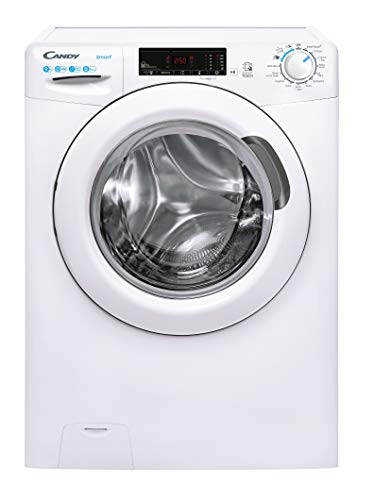A 9kg Washer Machine Is a Good Size For a Family and Provides Plenty of Flexibility
A 9kg washing machine is the perfect size for families with a large number of children. It's got plenty of flexibility. They're not as expensive as you might imagine either.
Kg is the weight of your laundry, dry or wet. It is the maximum amount a machine will wash in a single wash.
A larger capacity drum is great for bulky items like duvets. You can wash them at home instead of going to the laundry.
Capacity
The capacity of a washer is referred to the amount of dry laundry it can store in a single load. This measurement is typically expressed in kilograms, however it is also described in cubic feet. To determine the volume, measure the radius of the tub (the distance from the center of the tub to the edge of its covering). Multiply the radius squared by the depth of the tub and divide this number by pi (3.14).
While it's tempting to pick a washing machine with a large capacity, remember that the more clothes you put in a wash the more weight your load will be. Inputting too much laundry into the washer could cause damage and affect how long the machine will last. You should also consider the size of your family today and in the future. If you have kids, consider the size of their clothes and bedding.
A 9kg washing machine is perfect for large families and frequent washers since it can handle more laundry in one wash cycle. It's also great for large households that have a mix of textiles, such as silk, wool and linen.
A 9kg washer isn't just big but also comes with numerous features that help you clean your laundry faster. Some of these features include a sanitize rinse, which uses low temperatures to clean your laundry while being gentle on your clothes. Another feature is the AddWash function, which lets you add laundry items in the rinse process. This feature lets you wash clothes more efficiently, and also save energy and time.
Some washers that weigh 9kg come with a special down setting, which is designed to clean your bedding and duvets. This will help keep your family members healthy and comfortable by removing bacteria and pollen from your bedding. It is recommended that you clean your bedding every three months.
Flexibility
9kg front-loading washers come with a large drum that is able to handle massive loads. You can wash everyday clothes and bulkier items such as duvets in the same way. Many models also provide specific washing options for delicate fabrics and particular garments such as woollens, making them an ideal choice for mixed washing.
Our capacity guide will help you figure out the right size drum right for your household. A larger household will typically be able to handle a larger drum, whereas smaller households will find a smaller drum sufficient. But, keep in mind that washing up large quantities of laundry can take a long time and use lots of energy, so take note of how often you wash.
You'll need a washer that is able to adapt to your lifestyle and household, regardless of size. Look for features such as delay start, waterPerfect plus and smart sensor technologies that cut down on detergent usage and energy cost. Also, look for a model with an integrated dryer to save space and time.
Most modern washers feature a pulsator which mixes detergent and water using the aid of agitation to produce a powerful cleaning action. This can help reduce wrinkles in your laundry and is especially crucial for bulky items like duvets.
You'll need a washer with various programs that will make your laundry time more efficient and quicker. Some washers come with a Quick Wash programme that reduces the time of a cycle to around two hours, whereas others come with woollen-specific cycles and added steam to reduce the time spent ironing. Some have a stop add go' function that allows you to add additional laundry to the machine once it has begun, thereby saving time and energy.
If you are worried that the 9kg model may not be large enough, there is a model of 10kg that can comfortably accommodate a large duvet of king size without overflowing. Some washers are also smaller than regular washers. This makes them easier to place under your counter without sticking out. This is particularly useful in the case of cabinets that are small.
Noise
Washing machines can make quite a lot of noise especially during the spin cycle. This could be due unbalanced loads or vibrations in the machine. It could also be caused by a noisy motor. The most frequent cause is a damaged drum. Debris such as coins can be caught in the drum's interior and cause a lot of noise during the washing process. These types of objects are more frequent that people realize, and it is important to check your washing machine regularly to ensure that there aren't any debris in the.
Other causes of loudness could be due to the incorrect temperature of the water or air filter that is dirty, or problems in the bearings at the rear drum. The bearings are responsible for making sure that the inner drum is running smoothly and efficiently. If they're damaged and cause loud squeaking, or even grinding sounds. If you are experiencing these issues then it is recommended to contact the manufacturer and request a new part.
Another cause of noise is air turbulence, that can be caused by unbalanced loads in the machine. This can also cause vibrations of the cabinet, resulting in acoustic noise. This kind of sound can be difficult to detect and can have an impact on the overall performance of the appliance.
A method of assessing the acoustic properties of home appliances using a new technique has been developed. This method combines the measurement of sound intensity and vibration measurements. washing machine 9kg allows the acoustic performance of washing machines to be assessed precisely. This will help manufacturers improve their products by making them quieter.

The experiment used front-loading washing machines with a laundry capacity of 9 kg. The experiment was conducted using an aluminum tub suspended from the base of the machine with springs and three shock absorbers with free-stroke friction. The acoustic emissions from the cabinet's vibration and the movement of drum were evaluated. The acoustic power of each transmission path was calculated based on these recordings. The results showed that non-resonant paths had the most impact on the most high frequency. The effect was lessened with increasing frequency. The radiating path, on other hand, influenced all frequencies and was most prominent at 125 Hz.
Energy
The energy efficiency of a washer is measured by the amount of water and electricity it consumes per cycle. The energy efficiency of a washing machine can be improved or decreased dependent on the size and type of wash load, and the energy-saving features selected. Eco modes, for instance, allow smaller loads to be washed with less energy and water. Other features that save energy include a delayed start, stain care settings, and variable spin speeds.
In general, machines with larger capacities consume more energy. If the washer comes with energy-saving features, its energy consumption will be lower than one with the same capacity but without energy-saving features.
The capacity of a washing machine is measured in kilograms of cotton. This measurement is the maximum amount of dry laundry that an appliance can wash efficiently in a single cycle. The greater the capacity rating, the more clothes can be cleaned in one cycle. This is ideal for families with a large number of children and those who regularly wash large items.
In the last 10 years the last decade, a variety of new washing machines with ever-increasing capacities have come onto the European market. During the same period, European households have shrunk. This is a problem that could hinder the attainment of energy efficiency policy goals for these appliances.
This paper examines this divergence and outlines several policy measures to tackle it. This includes the inclusion of information regarding programme duration on the labels for energy, the inclusion of time as a factor in the energy efficiency index calculation and the setting up of a maximum program duration.
This paper presents a modeling study that explores the impact of these different policies on the evolution of market of washing machines with different capacities and durations of programme. The analysis reveals that rescaling the label to reflect energy efficiency regains some of its differentiation potential and makes it more probable that washing machines can achieve higher energy efficiency levels in a normal business scenario. The rescaling can also lead to a more effective realisation of energy efficiency policies.
